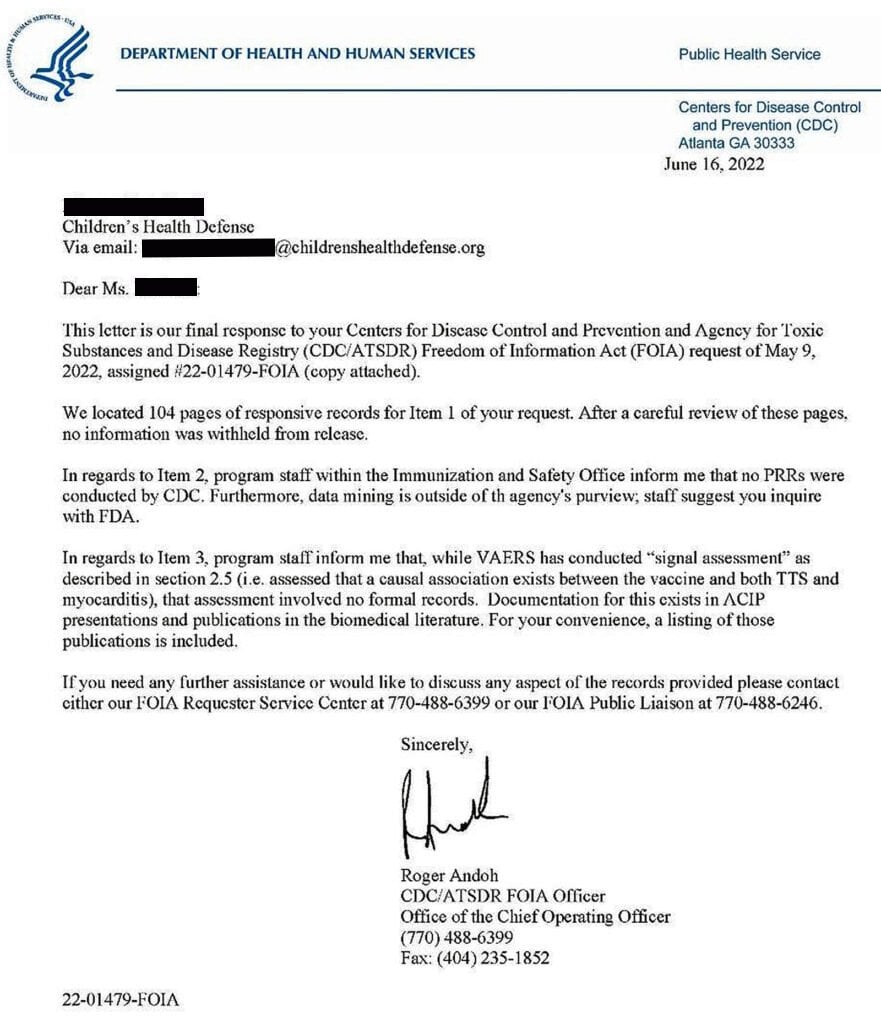
Experimental gene therapeutics against Covid, aka Covid vaccines, have been prescribed and often mandated to all “eligible” Americans. Just recently, the recommendation to take them has been expanded to include infants as young as six months old. Federal health authorities and the Biden administration continue to claim the shots are “lifesaving” and “safe and effective.” Apparently though, the claim of safety is speculative at best, since the government admitted it has been ignoring post-marketing adverse reactions submitted to its primary monitoring database.
According to a report posted by Children’s Health Defense (CHD) on Tuesday, the Centers for Disease Control and Prevention (CDC), whose mission is to “increase the health security of our nation,” did not pay attention to its vaccine-safety system called the Vaccine Adverse Event Reporting System (VAERS) when it came to Covid shots.
According to the CDC website, VAERS is the nation’s early-warning system that monitors the safety of vaccines after they are authorized or licensed for use by the U.S. Food and Drug Administration (FDA). It is not designed to determine if a vaccine caused or contributed to an adverse event, yet it is essential to help detect “unusual or unexpected reporting patterns of adverse events (AEs) for vaccines.” Healthcare providers and vaccine manufacturers are required by law to report certain events after vaccination, such as death, life-threatening conditions, hospitalizations, birth defects, multisystem inflammatory syndrome, and other serious events.
In May, CHD filed a FOIA request with the CDC about its VAERS monitoring activities.
In response, the agency wrote that it did not perform any data mining in VAERS and did not analyze safety signals, a procedure formally known as proportional reporting ratios (PRR’s).
CHD explains:
This is a method of comparing the proportion of different types of adverse events reported for a new vaccine to the proportion of those events reported for an older, established vaccine.
If the new vaccine shows a significantly higher reporting rate of a particular adverse event relative to the old one, it counts as a safety signal that should then trigger a more thorough investigation.
In other words, the CDC is supposed to constantly analyze reports of adverse events to new vaccines that it receives through VAERS. If it sees that the number “significantly” exceeds the number of reports submitted for other vaccines, then it should suspend administration of the new vaccines until the investigation is done to rule out the link between the vaccine and the AEs.
The report describes PRRs as “one of the oldest, most basic and most well-established tools of pharmacovigilance.” It continues, “The calculations are so straightforward that the CDC automated it several years ago, so it could have been done at the press of a button.”
Children’s Health Defense quoted a CDC briefing document that states that the agency “will perform PRR data mining on a weekly basis or as needed.”
The CDC, however, disregarded its duty to keep an eye on PRRs, and admitted as much.
According to the letter sent to CHD, “no PRRs were conducted by CDC.” It added, “Furthermore, data mining is outside of [the] agency’s purview,” and suggested that the nonprofit send its inquiry to the U.S. Food and Drug Administration (FDA), which co-manages the database:

The CHD report indicates that the FOIA request has been submitted to check if CDC’s sister agency was more vigilant in monitoring safety signals for the novel shots.
The claim that the monitoring of safety signals is outside of the agency’s purview is rather surprising, since CDC officials have repeatedly stated that they were watching VAERS “extremely carefully” and that they have seen no “safety signals” in VAERS associated with heart inflammation, for example. The VAERS fact sheet (pdf) clearly says that all reports are being “carefully monitored” by the CDC and FDA.
CHD also points out that the agency failed to create “tables of the top 25 adverse events reported in the previous week, tables comparing different vaccine manufacturers, or tables of auto-immune diseases.”
In addition to that, the monitoring only began in April 2021, while the administration of Covid shots started in mid-December 2020, which suggests that many reports might be missing.
According to OpenVAERS.com, between the vaccines’ rollout for the general public in April 2021 and June 10, 2022, VAERS had received a total of 1,301,354 reports of AEs to Covid shots. Of them, 28,859 were fatal. In 161,121 cases the vaccinee required hospitalization, and 53,989 people were left permanently disabled as an alleged result of the Covid shot.
Most occurrences of death possibly linked to the Covid shots occurred on the same day of the shot or the day following inoculation.
There are nearly 50,000 reports of AEs in children aged five to 17.
According to CDC’s parent entity, the U.S. Department of Health and Human Services (HHS), VAERS reflects only a “small fraction” of all adverse reactions to the vaccines and “varies wildly.”
Some observers, like Steve Kirsch, California tech entrepreneur and founder of the Vaccine Safety Research Foundation (VSRF), have estimated that the VAERS underreporting factor for Covid shots is 41 — which means that to get an actual number of AEs presumably linked to Covid shots, one should multiple the VAERS numbers by 41.
VAERS is a part of the larger vaccine safety monitoring system that the government presumably utilizes to ensure vaccine safety. The government has come under scrutiny over hiding or distorting Covid vaccine safety data in at least two other systems: V-Safe, which allows vaccine recipients to directly report their adverse reactions to the CDC, and the Defense Medical Epidemiology Database (DMED), used by the U.S. military.




